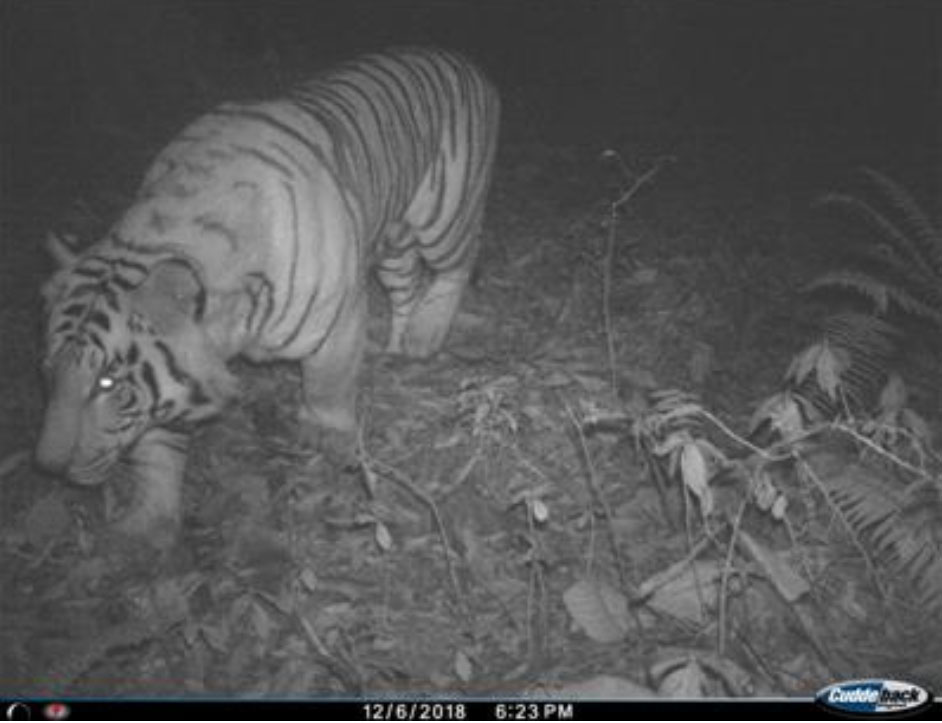 First-ever camera footage of Royal Bengal Tiger in Sikkim
First-ever camera footage of Royal Bengal Tiger in Sikkim
Monday, Jan 7, 2019:
DECHEN LACHUNGPA
Divisional Forest Officer,
East Wildlife Division
History has indeed been created with the first-ever camera footage of the Royal Bengal Tiger roaming the forests of Pangolakha Wildlife Sanctuary, East Sikkim, captured on the night of December 6, 2018 at 6:23 pm and 7:00 pm near Goru Jurey at an altitude of 9583 ft.
Up until the late 80s, there has been oral narratives of tigers freely roaming the forests of Sikkim, having migrated from the neighbouring Neora Valley National Park of West Bengal. The tigers crossed into Sikkim’s Pangolakha Wildlife Sanctuary and made their way to the Assam Reserve Forest (altitude 5000 ft, opposite Tsongmo Lake). After two days of kill, it moved to Rateypani (6000 ft) in the Bulbuley Reserve Forest and thence migrated further upwards towards North Sikkim through Phamthang Reserve Forest (6000 ft), spending a week while feeding on the resident’s livestock. After Phamthang, it arrived at the Toong and Naga Reserve Forest (7000ft).
This migration of tigers to Toong and Naga coincided with the seasonal winter migration of herds of cows from Lachung and Lachen during January to mid-March. From here, it moved to Chungthang and thence onwards to Lachung and further higher up to Chuba at 10000ft where it killed again. The arrival of tiger into these areas caused losses to the villagers and the people were even fearful of mentioning its name and referred to the tiger respectfully as ‘Azo’ (grandfather). They made smoke offerings to prevent the killings of livestock by tigers.
During 1978, a team comprising of Late P.O. Pazo, then Chief Wildlife Warden, S.T Lachungpa, then Assistant Conservator of Forests and Late Chezung Lachungpa, then Range Officer, conducted a survey of the movement of tigers by questioning village elders and former shikaris and confirmed this migration of tigers from East to North of Sikkim. At that time, wildlife expert N.D Jayal remarked that moving of tigers right up to 10000 ft was an unusual phenomena and could be attributed to the tigers developing a taste for yaks.
No doubt, during the 1990s, tiger pugmarks were reported from inside the Pangolakha Wildlife Sanctuary and in March 2009, tiger pugmarks have been seen near Jelepla at an altitude of 10,000 ft, with approximately 70 meters of the animal track discovered. Roars have been heard, pugmarks have been seen, tiger kills have been described but a visual capture of the Royal Bengal Tiger roaming the forests of Sikkim calls for a moment of celebration.
In an era when tigers have been listed as highly protected Schedule-I species, due to its dangerously dwindling population, nearing extinction, the presence of tigers in Sikkim forests is an indication of the existence of a healthy forest eco-system flourishing in our State. It is an affirmation of the positive consequences of the Sikkim government’s long-term visionary and pro-environment policies of conservation and protection of our Forests.
Much appreciation goes to the team of Field Forest Officers of the North Pangolakha Wildlife Range, East Wildlife Division led by Range Officer Roshan Tamang who spent days positioning camera traps in strategic locations inside the forests of Pangolakha with funding received from the JICA-assisted Sikkim Biodiversity Conservation and Forest Management Project. This visual footage of the tiger is just the beginning and a concrete base upon which a much detailed study on migration of tigers to Sikkim has to be conducted.
(* The historical narrative of tigers migrating from Pangolakha, East Sikkim to North Sikkim have been detailed after interviewing a senior retired forest officer with vast knowledge on the forests of Sikkim)